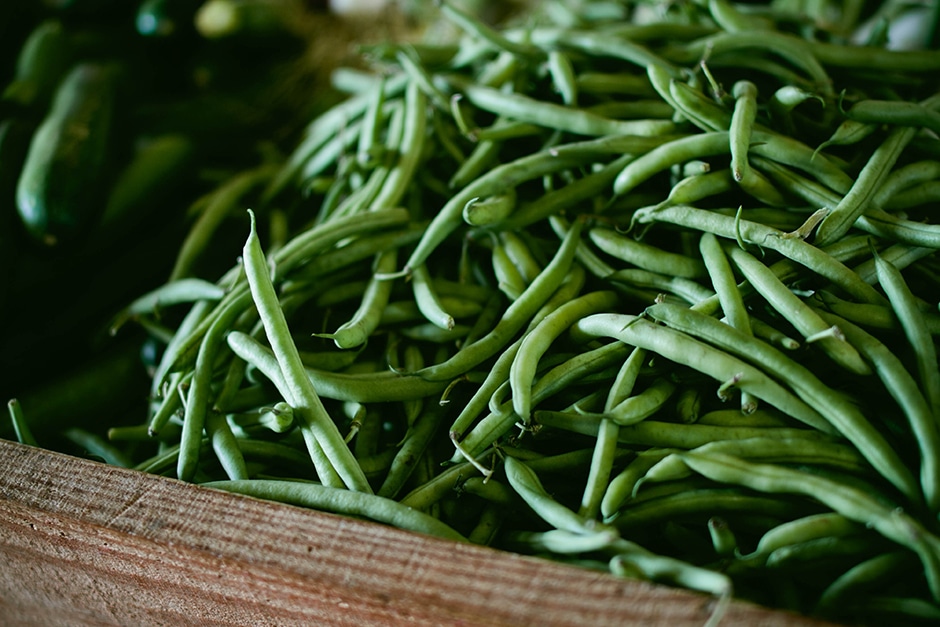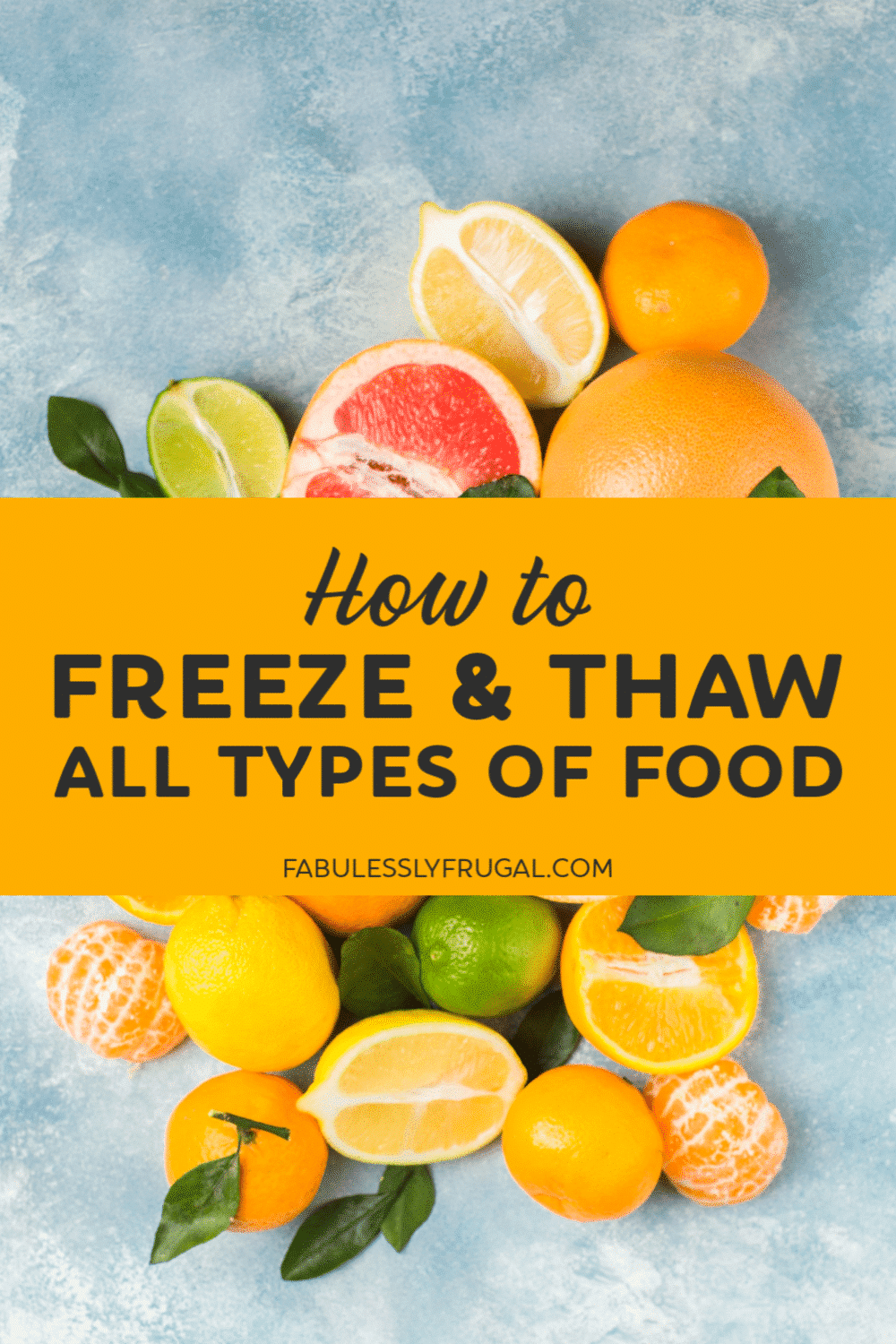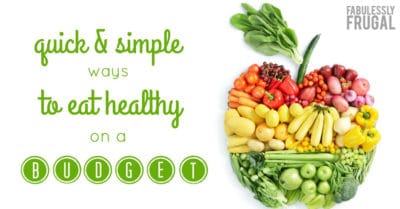How to Freeze Food: Complete Food Freezing Guide
Save Time and Money By Freezing Food!
Preparing food ahead of time can be a great way to save money and help you out when you’re in a pinch. We’ve all been there before where we forgot to take something out in time for dinner, and having a freezer meal on hand can be a life-saver in those situations.
No matter what questions you have, here is the ultimate guide to freezing food, thawing it, and storing it, for amazing and easy dinners on a budget!
To Freeze or Not to Freeze?
The age-old question comes down to whether or not you should freeze something or if you might want to consider passing instead. When freezing certain items, the consistency might change or even the taste, so you want to be extremely careful when freezing certain items.
Of course, if you ever aren’t sure, a little trial and error can help you determine if you should freeze it in the future.
Foods That Freeze Well
There are a number of foods that freeze extremely well! While you may be limited in terms of use once they are frozen, they still can be frozen and enjoyed at a much later date!
- Fruit: great for smoothies
- Vegetables: dice or chop prior to freezing
- Milk: only if frozen into cubes to be used in future smoothies
- Meats: freezing meat cooked or uncooked is fine
- Baked goods: flash freeze for better storage
- Pasta: cooked, keep the pasta sauce separate
- Herbs: freeze in water using an ice cube tray
How to Freeze Fruit
Freezing fruits for smoothies make great, rich smoothies that have plenty of natural sugars. And because it is frozen, it can act as ice and make your smoothies nice and chilly.
The great thing you’ll notice is that many of these fruits have the same simple freezing process. You really just need to cut your fruit into pieces, lay them out on a cookie sheet, let it freeze, then bag it! So simple!
Check out these different fruits you can freeze and save for later! Also, check out how you can use frozen fruits to make smoothies and prepare them ahead of time. Check out these lunch box smoothies as well!
How to Freeze Mango
Mangoes are a gift. They are perfect for smoothies… or pretty much everything. If you freeze mangoes, you can enjoy them all year long!
To freeze your mangos, start by cutting them into cubes. I usually do this by hand but there are some kitchen gadgets you can use to make this easier. For example, check out these mango slicers on Amazon.
After you’ve cubed your mango, place the cubes on a baking sheet, cover with plastic wrap, and freeze for 24 hours. Once frozen you can transfer the cubes to a freezer bag.
How to Freeze Pineapple
Pineapples are another one of nature’s treats! Try freezing pineapple to enjoy in your smoothies (try this pineapple whip recipe) or in a fruit salad. The freezing process is just the same as with the mangos.
How to Freeze Peaches
You’ll be surprised how simple it is to freeze peaches! If you are growing peaches in your garden and have them growing out of your ears. Try freezing them, so that you can enjoy them all year long!
For freezing peaches, start by boiling them for 30-60 seconds and then stick them in an ice bath. Then, peel the peaches, remove the pits, slice, and then either freeze the peach slices on a baking sheet and transfer them to a freezer bag, or put them right into a freezer bag with water.
How to Freeze Vegetables
Vegetables are little more tricky to freeze. Not all vegetables freeze great, and if you don’t cut them prior to freezing, the thawing process can be a mess!
Here are some vegetables that are perfect for freezing. Follow the step-by-step process, and you can have some delicious vegetables for cooking later!
How to Freeze Green Beans
With frozen green beans, you can enjoy snacking and cooking with green beans all year long! Freezing green beans is way simpler and tastes way better than canning them.
To freeze your green beans, start by washing them and then pat them dry. After that, break the top of the bean off where it was connected to the plant and boil the beans for 2 minutes. Next, stick them in ice water for 2 minutes to stop the cooking process.
Now you just need to thoroughly dry your beans and freeze them. You can use the baking sheet method to freeze them, or you can stick them in a freezer bag and suck out as much air as possible. Another option is to use a FoodSaver vacuum sealer.
How to Freeze Corn
I love frozen corn! It tastes 100% better than canned corn. Plus, if you grow corn in the summer, you can freeze it and enjoy it all year around. There are so many different soups and meals that use frozen corn. Learning how to freeze corn will save you time and money!
To freeze your corn, start by boiling it and then putting it in ice water just like you did with the beans. Then, set your cob in the middle of an angel food cake pan, slice off the kernels, and then break them up with your hands after. You could also use a corn stripper to make this process faster.
Once you have all your corn kernels you can freeze them in a freezer bag or Tupperware, or you can use the baking sheet method.
How to Freeze Zucchini
I also love being able to enjoy zucchini all year round. There is so much you can do with zucchini. And when you have it frozen, the possibilities are endless!
To freeze your zucchini, start by either slicing or grating it. Then, do as you did with the veggies above: boil it and then stick it in ice water. After that just put it in a vacuum-sealed bag or freezer bag with as much air as possible sucked out.
Best Containers for Freezing Food
As you’ve seen from this post, you don’t really need anything fancy to freeze your food in. In many cases, all you need is a freezer bag with a zip-top! A vacuum sealer makes things easier and saves space in the freezer, but it’s not necessary.
Other than that, you can also find some awesome reusable freezer containers on Amazon if you prefer to go that route. Using containers is great if you know how you want to portion out your frozen food.
Foods That Don’t Freeze Well
There are some foods that despite our best efforts just don’t freeze well. Some of these may be due to consistency after they’re thawed, or that the taste makes it not worth it! Here are some foods that you want to avoid freezing:
- Full vegetables: If blanched they can be frozen well, but the consistency is just hard to work with after they thaw
- Block cheese: shredded cheese can freeze well, but block cheese just isn’t the same after it’s been frozen
- Dressings and other condiments: they tend to separate when frozen, so it’s best to buy them when you need them instead of freezing for later.
- Fried foods: with the exception of foods that are meant for the frozen food aisle, fried foods become soggy when thawed.
Thawing Food
If you want to create an amazing dinner with minimal effort, freezing food ahead of time can make meal prep a breeze! Here are a few tips on thawing food to make sure you get the best taste possible every single time!
Give Your Food Plenty of Time to Thaw In the Fridge
This is probably the hardest part for me when it comes to freezing and thawing foods. I don’t normally think about pulling it out until I need it most! But that is why I love my instant pot! I love being able to cook my frozen chicken in 45 minutes!
Most foods are going to need at least 24 hours or longer depending on the temperature of your fridge. Make sure to leave plenty of time to ensure it’s had time to thaw.
Think About the Type of Food
Some foods are better cooked from a frozen state while others should be thawed before use. The texture and taste can be greatly impacted by how long you let some food thaw. This is especially true for meats.
Try to Create Freezer Meals When You Can
This is a sure way to make sure that the ingredients you freeze come out great every single time! There are so many different meals that are good for freezing.
Right before you put the meal in the oven, freeze it and when you’re ready to cook it, take it out and put it in the oven. Check out this post with the 24 Best Freezer Meal Tips so that you can prepare your freezer meals right the first time!
Did You Find This Food Freezing Guide Helpful?
No matter what kind of food you are working with, I hope that this guide to freezing food has helped you learn to make the most out of the food you have!
Let us know if you have any other food freezing tips to share!
Other Posts You Might Like:
- 50 Healthy Make-Ahead Freezer Meals
- Easy Costco Freezer Meal Plans (Less Than $5/Meal!)
- 7 Meal Planning Tips That Will Save You Time and Money
- Prepear Review: Best Free Meal Planning App I’ve Ever Used!!
- 20+ Kitchen Tips and Hacks You Need to Know
Trending Posts
Comments
Leave a Reply
Report a Problem
Please select the problem you are facing with this deal:
- Price Increased
- Price Decreased
- No longer available
- Expired
- Link doesn't work
- Suggestion
- Compliment
- Other
Add more details:
Thank you for your feedback. We really appreciate it.
Enter your email address if you would like to receive a follow up.
Please Try Again































Love this all-encompassing guide! I just got a bunch of greens from my csa on a discount so I blanched and froze them and its nice to know I have something I can thaw and toss into another meal very easily.
Nice job Kathryn!